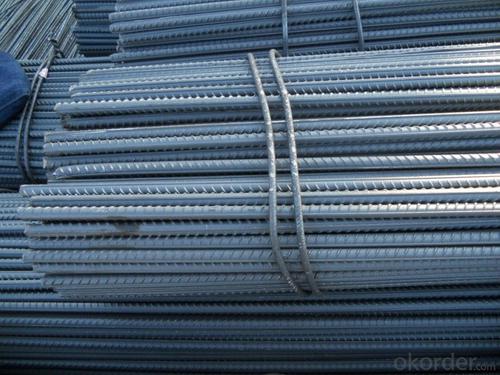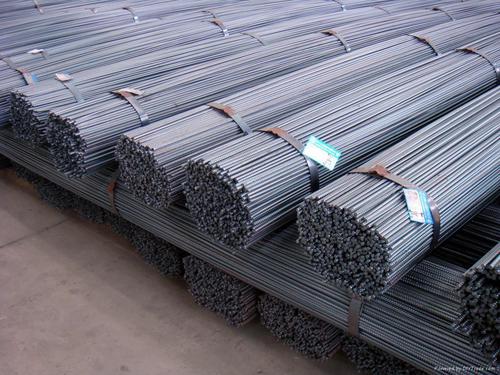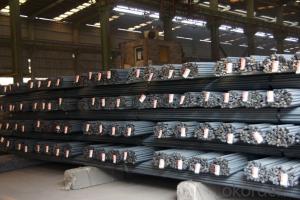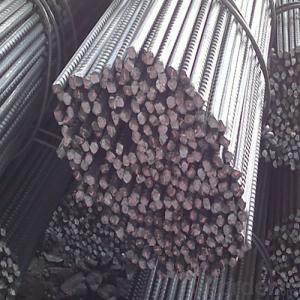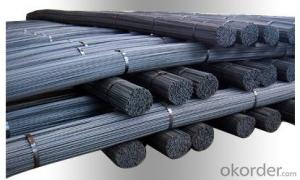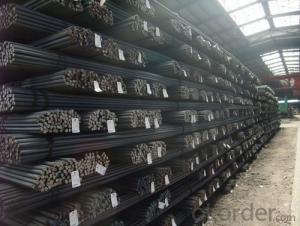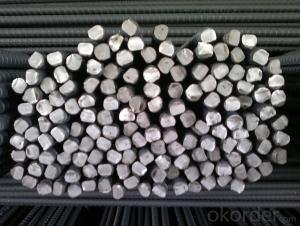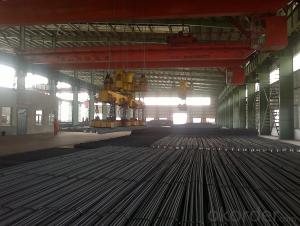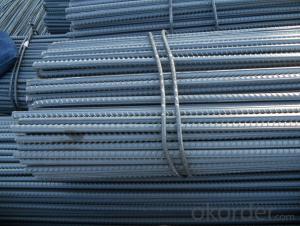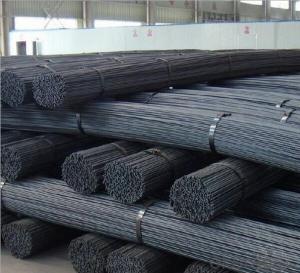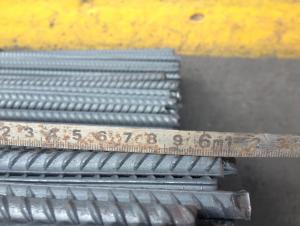Hot Rolled Deformed Bars with HRB 400-500
- Loading Port:
- Tianjin
- Payment Terms:
- TT OR LC
- Min Order Qty:
- 25 m.t.
- Supply Capability:
- 10000 m.t./month
OKorder Service Pledge
OKorder Financial Service
You Might Also Like
Product Description:
OKorder is offering high quality Hot Rolled Rebars at great prices with worldwide shipping. Our supplier is a world-class manufacturer of steel, with our products utilized the world over. OKorder annually supplies products to European, North American and Asian markets. We provide quotations within 24 hours of receiving an inquiry and guarantee competitive prices.
Product Applications:
Deformed bar is widely used in buildings, bridges, roads and other engineering construction. Big to highways, railways, bridges, culverts, tunnels, public facilities such as flood control, dam, small to housing construction, beam, column, wall and the foundation of the plate, deformed bar is an integral structure material. With the development of world economy and the vigorous development of infrastructure construction, real estate, the demand for deformed bar will be larger and larger..
Label: to be specified by customer, generally, each bundle has 1-2 labels
Product Advantages:
OKorder's Hot Rolled Rebars are durable, strong, and resist corrosion.
Main Product Features:
· Premium quality
· Prompt delivery & seaworthy packing (30 days after receiving deposit)
· Corrosion resistance
· Can be recycled and reused
· Mill test certification
· Professional Service
· Competitive pricing
Product Specifications:
Manufacture: Hot rolled
Grade: HRB400 – HRB500
Certificates: ISO, SGS, BV, CIQ
Length: 6m – 12m, as per customer request
Packaging: Export packing, nude packing, bundled
Grade | Technical data of the original chemical composition (%) | ||||||
C | Mn | Si | S | P | V | ||
HRB400 | ≤0.25 | ≤1.60 | ≤0.80 | ≤0.045 | ≤0.045 | 0.04-0.12 | |
Physical capability | |||||||
Yield Strength (N/cm²) | Tensile Strength (N/cm²) | Elongation (%) | |||||
≥400 | ≥570 | ≥14 | |||||
Theoretical weight and section area of each diameter as below for your information:
Diameter(mm) | Section area (mm²) | Mass(kg/m) | Weight of 12m bar(kg) |
6 | 28.27 | 0.222 | 2.664 |
8 | 50.27 | 0.395 | 4.74 |
10 | 78.54 | 0.617 | 7.404 |
12 | 113.1 | 0.888 | 10.656 |
14 | 153.9 | 1.21 | 14.52 |
16 | 201.1 | 1.58 | 18.96 |
18 | 254.5 | 2.00 | 24 |
20 | 314.2 | 2.47 | 29.64 |
22 | 380.1 | 2.98 | 35.76 |
25 | 490.9 | 3.85 | 46.2 |
28 | 615.8 | 4.83 | 57.96 |
32 | 804.2 | 6.31 | 75.72 |
36 | 1018 | 7.99 | 98.88 |
40 | 1257 | 9.87 | 118.44 |
50 | 1964 | 15.42 | 185.04 |
FAQ:
Q1: Why buy Materials & Equipment from OKorder.com?
A1: All products offered byOKorder.com are carefully selected from China's most reliable manufacturing enterprises. Through its ISO certifications, OKorder.com adheres to the highest standards and a commitment to supply chain safety and customer satisfaction.
Q2: How do we guarantee the quality of our products?
A2: We have established an advanced quality management system which conducts strict quality tests at every step, from raw materials to the final product. At the same time, we provide extensive follow-up service assurances as required.
Q3: What is the normal tolerance of Hot Rolled Mild Steel Angle Beams for Structures and for Buildings?
A3: Normally 3%-5%, but we can also produce the goods according to the customers' requests.
Images:

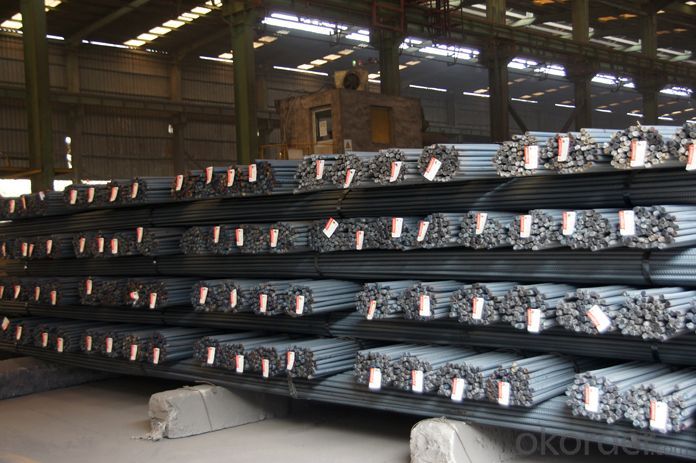
- Q: What are the guidelines for the proper spacing of steel rebars in slabs?
- The guidelines for proper spacing of steel rebars in slabs typically vary depending on the specific design and structural requirements. However, some general guidelines recommend a minimum spacing of rebars to be at least three times the diameter of the longitudinal bars. Additionally, transverse reinforcement should be placed at regular intervals, typically between 12 to 18 inches, to ensure adequate reinforcement throughout the slab. It is crucial to consult with a structural engineer or refer to local building codes and standards to determine the specific spacing requirements for a given project.
- Q: What are the different corrosion protection methods for steel rebars?
- Steel rebars commonly used in reinforced concrete structures have various corrosion protection methods available. These methods aim to prevent or minimize rebars' corrosion, which can significantly weaken the overall structure. 1. Concrete Cover: An effective corrosion protection method involves providing a sufficient thickness of concrete cover over the rebars. This creates a physical barrier, preventing the rebars from being exposed to corrosive elements. 2. Galvanization: Another method is to coat the rebars with zinc through a process called galvanization. This protective layer acts as a sacrificial anode, corroding before the rebars and enhancing their resistance to corrosion. 3. Epoxy Coating: A popular approach is applying a layer of epoxy resin over the rebars. This coating acts as a barrier, preventing moisture and corrosive substances from reaching the rebars. 4. Cathodic Protection: An electrochemical method known as cathodic protection involves using a sacrificial anode or an impressed current system. In a sacrificial anode system, a more reactive metal like zinc or magnesium is connected to the rebars, sacrificing itself to prevent corrosion. In an impressed current system, an external power source supplies a protective current to the rebars, preventing corrosion. 5. Corrosion Inhibitors: Chemicals can be added to the concrete mix or applied as a surface treatment to act as corrosion inhibitors. These substances create a protective film on the rebars' surface, blocking corrosive agents' access and preventing corrosion. 6. Stainless Steel Rebars: An effective method is to use stainless steel rebars, which have high resistance to corrosion. This makes them suitable for structures exposed to aggressive environments. It is important to consider various factors, such as environmental conditions, expected service life, and cost, when selecting the appropriate corrosion protection method. Regular inspection and maintenance of the system are also necessary to ensure its long-term effectiveness.
- Q: How do steel rebars contribute to the overall seismic performance of a structure?
- Steel rebars contribute to the overall seismic performance of a structure by providing reinforcement and strength. The rebars are embedded in concrete, creating a composite material that enhances the structural integrity and resistance to seismic forces. They help to distribute the applied loads more evenly, absorb and dissipate energy during earthquakes, and prevent the concrete from cracking or failing under stress. Overall, steel rebars significantly improve the resilience and safety of structures in seismic events.
- Q: How do steel rebars contribute to the overall aesthetics of a building?
- Steel rebars do not directly contribute to the overall aesthetics of a building as they are typically hidden within the concrete structure. However, their presence is crucial for providing structural integrity and strength, ensuring the building's safety and durability.
- Q: How do steel rebars impact the overall energy efficiency of a structure?
- Steel rebars can have both positive and negative impacts on the overall energy efficiency of a structure. On one hand, steel rebars can enhance the structural integrity and durability of the building, leading to a longer lifespan and reduced energy consumption for repairs and maintenance. Additionally, steel rebars can be used to reinforce concrete, which provides better insulation and thermal efficiency. On the other hand, the production of steel rebars requires significant energy and emits greenhouse gases, contributing to the carbon footprint of the structure. Therefore, the overall energy efficiency of a structure depends on various factors, including the design, construction techniques, and the use of sustainable materials alongside steel rebars.
- Q: What is the role of steel rebars in bridge deck construction?
- Steel rebars play a crucial role in bridge deck construction as they provide reinforcement and strength to the structure. They are used to distribute and withstand the load and stresses that the bridge deck may experience, ensuring its stability and durability over time.
- Q: How do steel rebars affect the overall durability of a structure?
- Steel rebars play a crucial role in enhancing the overall durability of a structure. By providing reinforcement to concrete, they contribute to the structural integrity and longevity of the building. The presence of rebars helps to distribute and withstand tensile forces, increasing the load-bearing capacity of the structure. One of the primary benefits of steel rebars is their ability to resist cracking and prevent the propagation of cracks in concrete. As concrete is weak in tension, the introduction of rebars helps to absorb and distribute tensile stresses, reducing the likelihood of cracks forming. This is particularly important in areas prone to seismic activity or other dynamic forces. Moreover, rebars also offer excellent resistance to corrosion, which is a common threat to the durability of structures, especially those in coastal or humid environments. The steel used in rebars is typically treated with corrosion-resistant coatings or made from stainless steel, ensuring long-term protection against rust and deterioration. The inclusion of steel rebars in concrete structures also enhances their resistance to fire. Steel has a high melting point, and when embedded in concrete, it acts as a heat sink, slowing down the spread of fire and providing additional time for evacuation and firefighting efforts. In summary, steel rebars significantly contribute to the overall durability of a structure by improving its resistance to cracking, corrosion, and fire. Their ability to reinforce concrete and withstand tensile forces ensures the structural stability and longevity of the building, making it more resilient to various environmental and man-made hazards.
- Q: What is the difference between three - grade steel and other grades?
- Because of the difference of chemical composition and ultimate strength of steel bars, they are different in toughness, cold bending, fatigue resistance and so on.
- Q: How do steel rebars enhance the load-bearing capacity of a structure?
- Steel rebars enhance the load-bearing capacity of a structure by providing reinforcement and strengthening to the concrete. They are essentially embedded within the concrete and act as a skeleton or framework, offering additional strength to the structure. The primary function of steel rebars is to resist tension forces that the concrete alone may not be able to withstand. When a structure is subjected to heavy loads or external forces, such as earthquakes or wind, the concrete may crack or fail under the stress. However, the presence of steel rebars helps distribute and absorb these forces, preventing the concrete from breaking apart. The ribbed surface of rebars improves the bond between the steel and the concrete, ensuring effective load transfer between the two materials. This bond allows the rebars to resist tension and compression forces, as well as shear forces, resulting in an overall increase in load-bearing capacity. Furthermore, steel rebars help control and limit the width and depth of cracks that may occur in the concrete. By restraining crack propagation, rebars prevent the cracks from expanding and compromising the structural integrity of the building. This is particularly crucial in earthquake-prone regions, where the ability of a structure to withstand ground movements is of utmost importance. In addition to enhancing the load-bearing capacity, steel rebars also contribute to the durability and longevity of a structure. They have high tensile strength, which means they can withstand significant pulling forces without deforming or breaking. This property ensures that the structure remains stable and secure over time, even under dynamic or extreme loading conditions. Overall, steel rebars play a vital role in enhancing the load-bearing capacity of a structure by reinforcing the concrete, increasing its resistance to tension forces, and controlling crack propagation. Their presence significantly improves the structural integrity, durability, and safety of buildings, making them an essential component in modern construction practices.
- Q: How do steel rebars affect the overall creep and shrinkage of concrete structures?
- Steel rebars have a significant influence on the overall creep and shrinkage of concrete structures. The presence of rebars helps to control and minimize the shrinkage of concrete by providing restraint and reducing the amount of drying shrinkage. Additionally, rebars contribute to the overall stiffness of the structure, decreasing the potential for creep deformation over time. Therefore, steel rebars play a crucial role in mitigating both creep and shrinkage in concrete structures, ensuring their stability and durability.
Send your message to us
Hot Rolled Deformed Bars with HRB 400-500
- Loading Port:
- Tianjin
- Payment Terms:
- TT OR LC
- Min Order Qty:
- 25 m.t.
- Supply Capability:
- 10000 m.t./month
OKorder Service Pledge
OKorder Financial Service
Similar products
Hot products
Hot Searches
Related keywords



